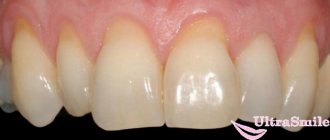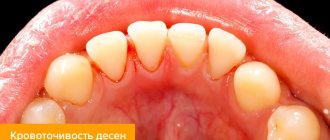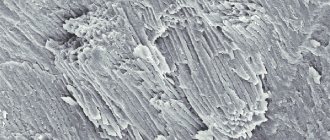Structure of tooth dentin –
Dentin consists of calcified intercellular substance, which is penetrated by the so-called “dentinal tubules” (dentinal tubules), which ensure trophism and mineralization of dentin. Dentinal tubules run radially, in the coronal part of the tooth - in the direction from the wall of the pulp chamber to the enamel-dentin border, and in the root part of the tooth - from the wall of the root canal to the surface of the tooth root. However, if in the root part of the tooth, as well as in the area of the occlusal surface of the tooth crown, the dentinal tubules have an almost straight shape, then in the lateral parts of the crown they will already be S-shaped.
Dentinal tubules (electron microscopy) –
The diameter of the tubules ranges from 0.5 to 4 microns, and they will be wider in the internal parts of the dentin and gradually narrow outward (like a flattened cone). Inside the tubules there are processes of odontoblasts, unmyelinated nerve fibers, and tissue fluid also circulates. The odontoblasts themselves are located outside the dentin - their bodies are located in the superficial layer of the pulp, and their processes, passing along the entire length of the dentinal tubules, end in the area of the enamel-dentin border (Fig. 8).
The lateral canals extend from the dentinal tubules in a perpendicular direction. There are especially many of them in the predentin and inner layers of peripulpal dentin (100–200 µm from the border with the pulp). There are quite a few of them in the middle sections of dentin and again become numerous at the periphery - in the area of mantle dentin. In the lateral canals there are lateral branches of the processes of odontoblasts, which anastomose with each other. Let us recall that it is odontoblasts that participate in the formation of the organic dentin matrix and its further mineralization.
Odontoblasts, predentin and dentinal tubules (histology) –
Please note that on the histological specimen (Fig. 6) predentin looks like a light stripe, turning into a zone with spherical formations of a darker color (globules). The predentin layer has minimal mineralization and consists mainly of an organic matrix - intertwined collagen fibrils (Fig. 7). Spherical formations at the border of predentin and peripulpar dentin are nothing more than “calcospherites”, which are foci of mineralization. Low-mineralized dentin located around such globules is called “interglobular.”
Subsequently, the globules merge, forming homogeneous, highly mineralized dentin. It is also worth noting that when the dentinal tubules approach the enamel-dentin border or the cementum layer, their ends form large terminal branches (similar to tree branches). A number of terminal segments of dentinal tubules penetrate even through the enamel-dentin boundary, forming the so-called “enamel spindles”. According to most authors, these formations are involved in the mineralization of deep layers of enamel.
Architectonics of dentinal tubules –
The density of the tubules differs in different layers of dentin. Some of them are most densely located in the peripulpal dentin, where there are from 50,000 to 75,000 of them per 1 mm2 of dentin. For 1 mm2 of the mantle layer of dentin there will be only from 15,000 to 30,000. But let us draw your attention to the fact that in this case it decreases not the number of tubules as such, but precisely the density of their location in the surface layers of dentin (due to their radial direction and with a simultaneous increase in the area of the outer layers).
The structure of tooth enamel -
The main structural unit of enamel is the so-called “enamel prisms”, between which there is an interprismatic substance that glues the prisms together. In this section we will analyze their structure, and also talk about the structure of apatite crystals, the structure of the interprismatic substance, as well as such formations as enamel plates and bundles, enamel spindles.
1) Enamel prisms and their structure -
Enamel prisms are formed from apatite crystals that are adsorbed onto an organic matrix. The latter has a fibrillar structure - in the form of a thin protein mesh, which evenly penetrates all the prisms and the interprismatic substance. The prisms themselves have the shape of thin elongated formations that pass through the entire thickness of the enamel - from the enamel-dentin border to the tooth surface (Fig. 4-5). The enamel of one tooth consists of a total of several million enamel prisms.
Longitudinal section of enamel prisms –
The thickness of the prisms ranges from 3 to 6 microns, and as they approach the enamel-dentin border to the surface of the tooth, their diameter increases by approximately 1.5-2 times. This is due to the fact that the area of the enamel-dentin junction (where the prisms begin) is significantly less than the surface area of the tooth enamel. The prisms have a radial direction and lie in relation to the enamel-dentin border - almost at a right angle. But, as for the enamel surface, in the area of occlusal surfaces they will lie parallel to the long axis of the tooth, and on the lateral surfaces of the crown - perpendicular to the tooth axis.
As for the length of the enamel prisms, it will depend on the thickness of the enamel layer on different surfaces of the tooth crown, and the length of each prism will in any case be greater than the thickness of the enamel layer. The latter becomes possible due to the fact that the bundles assembled from enamel prisms have wavy bends along their course (in the shape of the letter S). The appearance of such a radial structure with pronounced S-shaped bends in the enamel is associated with a functional adaptation that prevents the appearance of radial cracks under the influence of occlusal load (Fig. 6).
Cross section of enamel prisms –
On transverse sections of teeth, prisms can have oval, hexagonal, polygonal, but most often - the shape of arcades that resemble fish scales or a keyhole (Fig. 7). According to R. Frank, this form of prisms occurs due to the uneven mineralization of enamel prisms that occurs during their development. Thus, one side of the prisms mineralizes and becomes hard earlier than the other, which causes compression of the softer part of the prism. According to research by J. Saot and N. Symons, only 2% of prisms had a regular hexagonal shape, 57% had an arcade shape, another 31% of prisms were polygonal or oval, and another 10% had an irregular shape.
It is worth noting that the surface of each enamel prism is surrounded by a shell, which is called the “prism cortex”. However, such a shell is not considered as an independent formation, and is distinguished by the fact that it is less mineralized and contains significantly more enamel proteins than the rest of the prism. As a result, the shell is more resistant to acids (compared to the prism core). Below you can see an electron microscopy image showing enamel subjected to acid demineralization for 5 days (Fig. 8). As we see, only the outer shell of the prisms and the interprismatic substance have been preserved.
Enamel prisms after demineralization –
Prismatic enamel –
However, the innermost layer of enamel, adjacent to the enamel-dentin junction, does not contain enamel prisms. This layer is often called the term “initial enamel” (the thickness of this layer is only 5-10 microns). This layer of enamel consists exclusively of small crystals of hydroxyapatite, only 3-5 nm thick. The formation of prismless enamel is due to the fact that in the initial period of its formation, enameloblasts still lack Toms fibers (Toms processes). Only later do enameloblasts begin to form short protoplasmic processes, which give rise to enamel prisms.
The outer layer of tooth enamel is formed in a similar way (at the final stages of its development). During this period, Toms' processes in enameloblasts already disappear, and therefore the most superficial layer of enamel (terminal enamel) will also be devoid of enamel prisms. The layer of the so-called “final enamel” is more pronounced in permanent dentition teeth, but in primary teeth, electron microscopy shows a predominantly prismatic structure of the surface layer of tooth enamel.
2) Features of apatite crystals –
We have already said above that of the different types of crystalline apatites, enamel contains the most hydroxyapatite [Ca10(PO4)6(OH2)], the share of which is 75%. Hydroxyapatite crystals are covered with a hydration shell 1 nm thick. The microspaces between apatite crystals are filled with water, which is called enamel fluid. The water content in enamel is about 2-3%, and its function is the transfer of ions, which ensures the processes of mineralization/demineralization.
In turn, the hydroxyapatite crystals themselves have the form of hexagonal plates - with an average length of about 200 nm (but crystals with a size of 500-600 nm, and even up to 1000 nm can be found), as well as a width of 40-90 nm and a thickness of 25-40 nm . The direction of the crystal axis in relation to the long axis of the prism differs in its different sections. In the central part, the crystals will lie parallel to the long axis of the prism, and on the periphery, they move away from this axis, forming an increasingly larger angle with it. For example, with an arcade-shaped enamel prism, this angle will be about 40–65°.
3) Interprismatic substance –
We have already said above that enamel prisms are, as it were, cemented in a thin layer of interprismatic substance, the thickness of which is less than 1 micron (Fig. 10). By the way, it is worth noting that with the arcade configuration of enamel prisms, the latter are in such close contact with each other that the interprismatic substance between them is almost completely absent. The interprismatic substance also consists of apatite crystals, which are located at an angle to the enamel prisms (often even at an angle of 90°).
The interprismatic substance is less mineralized than the enamel prisms themselves, and therefore, in comparison with them, it has less strength. As a result, cracks that occur in the enamel usually pass through the interprismatic substance, without affecting the prisms themselves. Below you can see longitudinal and transverse sections of the enamel, on which crystals of the interprismatic substance are located between the enamel prisms (at an angle to the enamel prisms).
Tooth enamel (electron microscopy image) –
4) Enamel plates and enamel bundles –
Such formations are characteristic of mature enamel (Fig. 12-13). Both plates and bundles are low-mineralized areas of enamel prisms and interprismatic substance, differing from each other only in position and shape. Enamel plates are very thin “sheet-like” structures that pass through the entire thickness of the enamel (most of them are in the neck of the tooth). They contain enamel proteins as well as organic matter from the oral cavity.
On enamel sections, they look exactly the same as enamel cracks, but are only filled with organic matter. It should be noted that they can serve as entry points for the development of caries. In turn, enamel tufts are small cone-shaped formations (resembling the shape of “spearing tufts of grass”) that extend from the enamel-dentin border. The distance between the beams is approximately 30 to 100 μm.
5) Enamel spindles –
Enamel spindles are flask-shaped structures that extend from the enamel-dentin border at a right angle (Fig. 14). Their formation is due to the fact that during tooth development, some of the processes of odontoblasts penetrate the enamel-dentin junction, which is apparently necessary for communication between odontoblasts and secretory anameloblasts. Thus, enamel spindles are structurally dentinal tubules.
In addition to odontoblast processes, enamel spindles also contain tissue fluid and other organic components. According to most authors, enamel spindles play an important role in the mineralization of deep layers of enamel from the dental pulp side. Below you can see exactly what enamel spindles look like:
6) What are Gunter-Schräger stripes –
We have already said above that enamel prisms have a wave-like curvature along their course (in the shape of the letters S). This leads to the fact that on a longitudinal section of a tooth it is impossible to cut each enamel prism strictly longitudinally along its long axis and along its entire length. Therefore, it turns out that some sections of the prisms will in any case be ground in the longitudinal direction, and their extensions – in the transverse or oblique directions. The areas of the prisms that will be dissected longitudinally look light (parazones). Sections of prisms cut transversely will appear dark (diazons).
As a result, a correct alternation of transverse and longitudinal sections of bundles of enamel prisms appears on the tooth section. When studied in reflected light, they appear in the form of dark and light stripes, crossing the entire thickness of the enamel in an arc in the radial direction. They start from the enamel-dentin junction and end in the superficial layer of enamel. Such stripes are called Gunter-Schräger stripes, and they can be clearly distinguished even with low magnification (Fig. 15-16).
Structure of dentinal tubules –
Dentinal tubules pass in the so-called dentinal tubules. The wall of each dentinal tubule is formed by the so-called “peritubular dentin,” which is characterized by a very high degree of mineralization and the absence of collagen fibers. Between the dentinal tubules there is the so-called “intertubular dentin”, which is characterized by a lower degree of mineralization and a large number of collagen fibers (fibrils). Dentinal tubules are hollow inside, which is why they are often called dentinal tubules.
Each tube is internally coated with a thin layer of organic matter - this layer contains a high concentration of glycosaminoglycans and is commonly called the Neumann membrane. In the center of the dentinal tubules there are processes of odontoblasts (Toms fibers). The space between the odontoblast process and the wall of the dentinal tubule is filled with dentinal fluid, which is similar in composition to blood plasma. In addition to the processes of odontoblasts and tissue fluid, they also contain non-myelinated nerve fibers (however, they can only be found in peripulpar dentin).
Scheme of the structure of dentin –
Peritubular and intertubular dentin –
During the process of dentinogenesis, intertubular dentin, located between the dentinal tubules, is formed earlier than peritubular dentin (24stoma.ru). The deposition of peritubular dentin occurs from within the already formed dentinal tubules (the processes of odontoblasts take an active part in this). The thickness of peritubular dentin from the pulp end of the tube is from 40 to 50 nm, and from the enamel-dentin border from 500 to 700 nm.
As we said above, peritubular dentin has a significantly higher mineralization. For example, the content of hydroxyapatite in it will be 40% higher than in intertubular one, but there are practically no organic components in it. This leads to the fact that when moderate caries occurs, peritubular dentin will be destroyed much faster than intertubular dentin. And as a consequence, the ongoing processes of demineralization will lead to the expansion of dentinal tubules and an increase in dentin permeability, including for pathogenic bacteria.
In turn, intertubular dentin contains many organic components, for example, calcified collagen fibrils with a diameter of about 75 nm (hydroxyapatite crystals are located along the axis of the fibrils). Collagen fibrils form a so-called “framework”, which serves as a basis for the deposition of mineral salts. Below you can see what the collagen framework of dentin looks like in electron microscopy images taken after its forced demineralization.
Features of dentin in temporary teeth
The thickness of dentin in a baby tooth is approximately half that of a molar. This is explained by its faster formation and shorter lifespan of a temporary tooth. The tissue in children is lighter, it contains fewer minerals, it is softer, it is better prepared, so the treatment of caries of milk teeth is faster. Peritubular dentin, in turn, is practically absent, the tubules are wider and are not subject to sclerosis. Intrauterine dentin is characterized by uniform mineralization.
Organic dentin matrix –
The organic matrix of dentin is located between the dentin tubules (in intertubular dentin). It consists of collagen fibrils and an amorphous substance located between them. It is interesting that the direction of collagen fibrils and their structure will differ in the mantle and peripulpar layers of dentin. This is due to the fact that during primary dentinogenesis, the organic matrix of mantle dentin is first produced, and only then the matrix of peripulpar dentin.
In mantle dentin, fibers running in a radial direction, parallel to the course of the tubules (“Korff fibers”) will predominate. But the peculiarity of Korff fibers is not only their directionality, but also the fact that they will consist of fairly thick fibrils united into conical-tapering bundles. Moreover, it is worth clarifying that the radial-parallel direction of Korff fibers is more typical for that part of the mantle dentin that is closest to the occlusal surface of the tooth crown. And on the lateral surfaces of the crown and in the root area, the Korff fibers acquire an increasingly oblique direction.
As we said above, the matrix of peripulpal dentin is formed later than that of mantle dentin. Odontoblasts during this period synthesize much thinner fibrils, which intertwine with each other (see figure below). These fibers will be located tangentially, i.e. they extend from the dentinal tubules at almost a right angle (they are called “Ebner’s fibers”). But collagen fibers are not the only component of the organic dentin matrix, and we must not forget about the amorphous substance surrounding them.
Collagen fibrils in peripulpar dentin –
Amorphous substance –
Collagen fibers are surrounded on all sides by a basic amorphous substance, which consists mainly of glycosaminoglycans (chondroitin sulfates). In addition to them, the organic matrix includes a large amount of non-collagen proteins (their share is about 20% of the organic dentin matrix). The amorphous substance also contains proteoglycans, which are formed as a result of the combination of chondroitin sulfates and non-collagenous proteins.
Non-collagenous proteins play an important role in the processes of dentin mineralization. Below we have listed their main varieties -
- calcium binding proteins
- bone morphogenetic proteins (BMPs),
- glycoproteins (fibronectin, osteonectin),
- calcium ATPase and alkaline phosphatase,
- collagenases and collagen-digesting enzymes necessary for the restructuring of the organic matrix.
In the organic basis of dentin, lipids (glycolipids and phospholipids) have also been identified, probably participating in the mineralization of the matrix.
Nerve fibers -
Unmyelinated nerve fibers penetrate into dentin from the peripheral parts of the pulp, and they can only be detected in predentin (they penetrate into it to a depth of several micrometers, and only rare fibers - to a depth of 100 to 200 microns). In addition, nerve fibers are not found in all, but only in some dentinal tubules. In the more peripheral layers of dentin, there are no nerve endings at all, and in this case the main role in the formation of pain impulses is played by dentinal fluid (changes in hydrodynamic conditions).
Features of the inorganic matrix –
Dentin consists primarily of calcium phosphate (in the form of hydroxyapatite crystals), as well as small amounts of calcium fluoride and carbonate.
Hydroxyapatite crystals in dentin are much smaller and thinner when compared with tooth enamel, and have the following dimensions - length 20 nm, width 18-20 nm, thickness 3.5 nm. Those. The crystals are quite small and needle-shaped. Electron microscopy made it possible to establish that these crystals are located not only outside the collagen fibers, but also inside them (located even between the collagen fibrils). Dentin is characterized by a special form of deposition of crystals of mineral salts. If, for example, in the main substance of bone tissue the deposition of mineral salts occurs evenly (in the form of tiny crystals), then in dentin the mineralization process occurs in several stages. At the first stage, the formation of spherical crystalline structures occurs (in the form of “globules” - calcospherites), between which areas with non-calcified or slightly calcified basic substance - interglobular dentin - are still preserved.
Globular and interglobular dentin (histology) –
Globular and interglobular dentin are best visible at the border of peripulpar dentin and predentin (in the coronal part of the tooth), because It is in this zone that mineralization of secondary-formed dentin actively occurs. In addition, it is in this zone that the largest calcospherites can be found. Gradually, the globules increase in size and merge, forming homogeneous, highly mineralized dentin.
What are Owen's lines and Abner's lines?
Primary (physiological) dentin is formed during the period of tooth formation and eruption. It is produced by odontoblasts at a rate of approximately 4-8 µm/day, and the activity of odontoblasts has periods of activity and rest. This periodic change in odontoblast activity leads to the presence of so-called growth and contour lines in dentin.
Owen's contour lines reflect the daily rhythm of dentin deposition by odontoblasts. They are located at right angles to the dentinal tubules and correspond to “rest periods” in the activity of odontoblasts. During these periods, much less intense mineralization of dentin will occur - with the formation of very small interglobular spaces. The number of Owen lines can increase in pathological conditions of the body that affect the processes of mineralization of hard dental tissues.
Ebner's growth lines correspond to a slower 5-day cycle of formation of the organic dentin matrix by odontoblasts, i.e. periods of less mineralization of the dentin base substance.
Dead pathways in dentin –
Also, so-called dead paths (on thin sections of teeth) can be found in dentin, which arise when some of the odontoblasts die. Some authors say that only the exposure of 1 mm of the child’s area leads to the death of up to 30,000 odontoblasts. At the same time, the processes containing in the dentinal tubules undergo decay; accordingly, the cavities of the dentinal tubules will be filled with decay products and gaseous substances.
Due to the presence of gases, such dentinal tubules (dead paths) appear black on polished sections of teeth. By the way, the term “dead paths” was coined by E. Fish. It is also worth noting that the sensitivity of dentin in such areas is reduced, and from the side of the dental pulp in these areas there will be increased production of tertiary dentin.
Secondary and tertiary dentin –
Secondary dentin is deposited (from the pulp chamber side) throughout the life of the individual, which leads to a gradual reduction in the volume of the pulp chamber. Secondary dentin, like primary dentin, is produced by odontoblasts. Secondary dentin differs from primary dentin (formed during the formation and eruption of teeth) by a less regular structure, which is expressed in a change in the direction and number of dentinal tubules and collagen fibers, as well as a lower degree of mineralization. The size of the dentinal tubules itself also decreases.
Deposits of secondary dentin occur more actively in the area of the roof of the pulp chamber, as well as in its side walls. In addition, secondary dentin is actively deposited in the area of the bottom of the pulp chamber (in multi-rooted teeth). In connection with all this, the shape of the pulp chamber gradually changes - the pulp horns become flattened, its volume decreases. An interesting fact is that in men the intensity of secondary dentin deposition is higher. In addition, it is noted that with age, the intensity of secondary dentin deposition decreases.
Another type of dentin is the so-called “tertiary dentin” (dentinum tertiarium), which is also called reparative or irregular. Unlike secondary dentin, which is produced fairly evenly from the inner surface of the pulp chamber, the formation of tertiary dentin occurs locally. Local dentin formation is caused by the influence of strong irritating factors on the tooth, for example, this occurs when the enamel is destroyed or increased abrasion, or dentin is exposed.
With slowly developing caries, the production of tertiary dentin allows, for some time, to prevent the penetration of pathogenic bacteria and their toxins into the pulp. Thus, tertiary dentin performs a protective function. It is also worth noting that tertiary dentin is also characterized by the incorrect direction of the dentinal tubules, or they may be completely absent.
Tooth dentin: histology
Below you can see the histology of tooth tissue in stunning resolution, as well as an excellent lecture on dentin morphology in English (if you wish, you can turn on subtitles and select translation from English into Russian in the settings).
Functions of cement
As noted above, cementoblasts are functional cells, and it is thanks to them that subsequent layers of cement are deposited. Layers of tissue are deposited throughout a person’s life, and over a lifetime the thickness increases by 2-3 times. The deposition of cement is necessary to maintain the normal length of the tooth during the process of natural wear, and “pushing out” of the tooth occurs. This compensatory function, which is necessary to maintain the normal dimensions of the clinical crown through tissue layering, is called passive tooth eruption. In some cases, the layering may intensify at the apex of the tooth roots with the loss of the “opposite” tooth on the opposite dental arch.
Dental cement is necessary for attachment of peripheral periodontal fibers to the neck of the tooth and the root.
Age-related changes in dentin –
We have already said above that with age, the deposition of secondary and tertiary dentin occurs, which also leads to a decrease in the size of the pulp. But in the teeth of older people you can often notice areas of dentin in which mineral salts are deposited not only in the main substance, but also inside the dentinal tubules themselves (this occurs against the background of degeneration processes of odontoblast processes). As a result, complete obliteration of the tubule lumen occurs, i.e. their physiological sclerosis.
Obliteration of the lumen of the tubules leads to a decrease in tooth sensitivity. In addition, the refractive indices of light in the tubules and in the main substance are aligned in this case, and therefore such areas of dentin appear transparent. Accordingly, such dentin is often called “transparent” or “sclerotic.” The formation of transparent dentin most often occurs first in the apical part of the root, and then slowly spreads towards the coronal part of the tooth. We hope that our article was useful to you!
Sources:
1. Higher professional education of the author in dentistry, 2. The European Academy of Paediatric Dentistry (EU), 3. “Anatomy of human teeth” (Gayvoronsky, Petrova). 4. “Therapeutic dentistry” (Politun, Smolyar), 5. “Histology of the oral cavity” (Glinkina V.V.).









